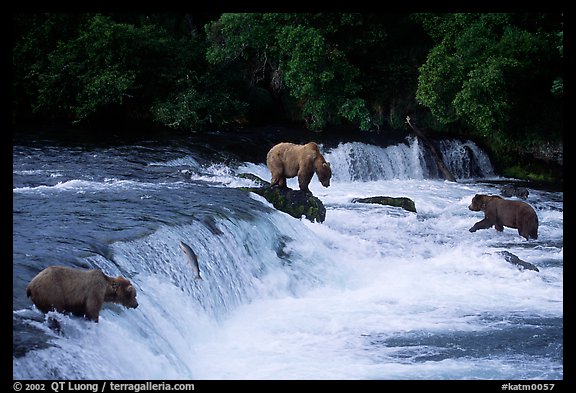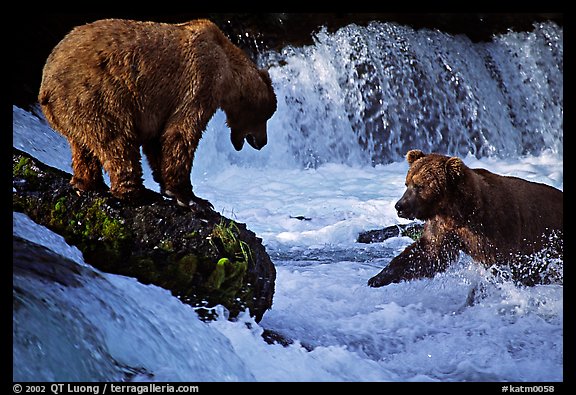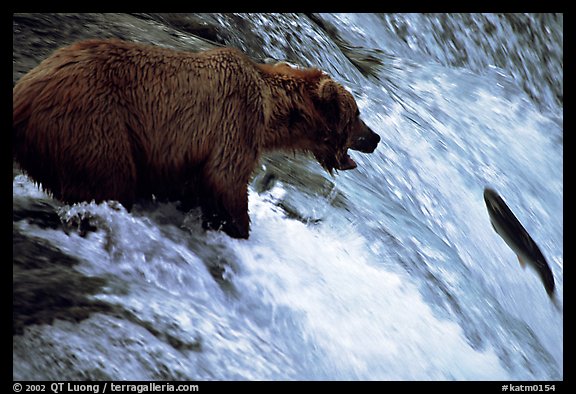Photo Spot 55: Katmai National Park – Brooks Falls
One Comment
Katmai National Park is located near the end of the Alaska Peninsula, in the middle of which is situated Lake Clark National Park. Although further from Anchorage than Lake Clark National Park, Katmai sees a slightly larger visitation, 9000 annual visits versus 6000, making it the fourth less visited National Park. Katmai was created in 1918 (as a National Monument) to preserve the Valley of Ten Thousand Smokes, a forty square mile, 700 foot deep ash flow deposited by Novarupta Volcano, whose eruption in 1912 remains the largest recorded in modern times.
Nowadays, most visitors come for the spawning grounds of Sockeye salmon, and the resulting brown bear population, both world’s largest. Katmai stands out as one of the few places in the world where humans can coexist right besides the bears in their own natural habitat. Although as a landscape photographer, my main goal was to explore the Valley of Ten Thousand Smokes, I could not miss the opportunity to see and photograph the bears. I planned my visit to coincide with the peak of the salmon run, at the beginning of July. This is the only time in the year to try and capture images of a brown bear catching a salmon flying mid-air by just opening its mouth. Later in the years, the bears may look more fat and happy, but the salmon are no longer swimming.
There is only one place to witness the event, Brooks Falls, where thousands of salmon try to jump the four-foot tall wide chute in a predestined journey to spawn at the place of their birth. Perched on the brink of the falls, and in the water below, the bears wait in anticipation of the coming feast.
To get there, I flew with a Alaska Airlines jet flight to the aptly named outpost of King Salmon. Although a flight from San Francisco to King Salmon (via Anchorage) costs more than $800, it can be booked for just 25,000 miles collected with the Alaska Airlines VISA card – one of the best reward programs out there. Katmai Air operates scheduled 20 minute flights of float planes from the river in King Salmon to Brooks Camp for about $200 round-trip. The flights are timed to coordinate with the arriving and departing PenAir and Alaska Flights. I was told that if your flight arrives late, the float plane won’t leave without you, and if it gets busy, they’ll just add one more flight. The main logistics difficulty is therefore to book a place to stay in Brooks camp during the salmon run window of late June-early July. The small lodge often sells out a year in advance. You can’t camp near the Brooks River except at the Brooks Camp National Park Service campground (which charges only a modest reservation fee).
When I arrived there, after attending the mandatory ranger briefing, I quickly understood why. The campground was surrounded by an electric fence to keep the bears out (like the dinosaurs in Jurassic Park !). As an additional precaution, all food and scented items had to be stored in a shed. In the park, the bears have the right of way. If a bear decides to take a nap on the trail, no visitors can come within 50 yards (100 yards if it is a mother with cubs) creating what is known locally as a “bear-jam”, which can delay by hours your movements in this otherwise small area. The delivery of our luggage had also been delayed by a bear, as there is only one path between the float plane landing site and the campground. Everything in Katmai revolves around bears.
Katmai has the world’s largest population of protected brown bears, more than 2000. With that many bears roaming around, encounters between humans and bears are inevitable, but since the bears are well fed from the salmon, with some rules a peaceful coexistence has been attained. The rules are simple: don’t get near them, don’t surprise them and don’t encourage them to see humans as a source of food. They have worked well, as no one had ever been killed by a bear at Brooks Camp. Credit for this must go to the Park Rangers, who spend most of their time “directing traffic” to keep people a safe distance from the bears, so that they don’t become too habituated. I though about other places where bears had been exterminated. Disharmony between bears and humans were not the bears fault. It was a human inadequacy brought about by our fear and distrust of them.
The only fatal bear attack that occurred in Katmai National Park was the predatory mauling of Timothy Treadwell and his girlfriend in 2003 on a remote section of the coast. As documented in his own book “Among Grizzlies” and then in the Werner Herzog’s 2005 (agenda-driven) film “Grizzly Man”, Treadwell spent 35,000 hours spanning 13 summers living alone amongst the bears, sometimes even touching them, without any previous mishap. Treadwell’s behavior with the bears was unusual and controversial, but he never encouraged others to approach bears as he did. It is tragically ironic that his death threatened to undo his and others work in trying to convince people to adopt a kinder attitude against bears.
I proceeded on the trail between Brooks Camp and Brooks Fall. It is only one mile-long, but I had to wait one hour for a “bear jam” at the floating bridge. After the bridge, the trail entered a forest covered in a lush carpet of mosses. I eventually arrived at the final observation deck, accessed via a series of locked gates – serving to keep the bears from coming up behind you on the decks.
A ranger took count of people, allowing only 40 at a time, placing a one hour limit on viewing and a keeping track of a waiting list when more than 40 were around. The platform provided a stable platform for my tripod, but it wasn’t possible to spread the its legs, and sometimes the view was obstructed. As slightly unpleasant as the crowding was, it reflected an interest in bear viewing that I thought could only be more positive than bear hunting, and a shift in attitude from fear to respect. Anyways, wildlife viewing was so spectacular and the bear behavior so captivating that I soon forgot about these inconveniences. It was like in a National Geographic documentary.
The dozen bears at the falls paid no attention to the people on the platform. They were close enough that my 100-400 f4.5-5.6 lens framed then tightly – although not as tightly as in the famous by Tom Mangelson or Galen Rowell that focus on the fish catching. In those days of slide film and low ISO, I wished I had a faster lens in the late afternoon, when the light improved (the platform faces North East). When the visitors who had came for a day trip left, the platform regained its tranquility. In the evening, as the light became too dim for photography, I just watched. On the way back to camp, the portion of the trail in the dark forest felt intimidating at dusk, as I could sense many bears lurking in the shadows, and was expecting one to step up in front of me at any moment. My close encounter with a bear would happen in opposite circumstances, but this will be the subject of another post…



See more images of Katmai National Park.
See more images of Brooks Falls.


QT ….. I hope you enjoyed Katmai, and My Alaska, as I enjoyed what you wrote about here. I also have enjoyed all of your images and follow you as much as I can ….. it would be a pleasure to meet you some where in Alaska when your there again and shoot with you. I live here in Alaska and it would be great to be able to take you down to where the Russian river bears are and have you photograph them also. Anyway I just want to say again ….. great work on all of your National Parks work.
“BUCK”